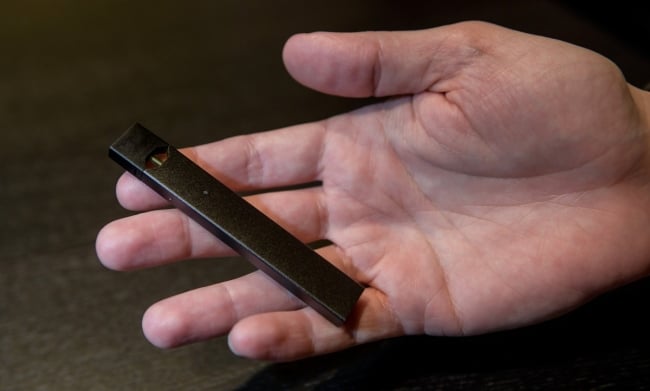You have /5 articles left.
Sign up for a free account or log in.

Juul
Getty Images
The move to snuff out cigarettes, tobacco products and smoking devices on college campuses has exploded in the past decade, and institutions are still declaring new bans entering the new year -- now with the complication of vaping.
While campaigns warning young men and women about the dangers of cigarettes have succeeded to a degree, and their popularity has waned, antismoking advocates (and colleges and universities) have attacked the ubiquitous trend of electronic cigarettes with some frustration. Juul and other thriving brands of e-cigarettes have been marketed as a healthy alternative for tobacco users. They can look like normal cigarettes and be as small as a USB flash drive -- and eliminate the stench of tobacco -- and thus can covertly be consumed in public and in dormitories. They can taste like wintergreen or strawberry.
College administrators are inheriting a group of students who find e-cigarettes quite appealing.
As of November, about 3.6 million middle and high school students currently use e-cigarettes, according to the U.S. Food and Drug Administration and the Centers for Disease Control and Prevention. In 2017, that number was two million. Despite the campus smoking prohibitions -- which might not even explicitly include vaping -- officials are struggling to enforce bans and wean students off e-cigarettes.
“This is a very important thing to do,” Stanton Glantz, director of the University of California, San Francisco, Center for Tobacco Control Research and Education, said of college vaping bans. “There’s very well-developed literature on the creation of smoke-free environments that suggest that this helps people quit smoking cigarettes and other forms.”
More than 2,270 campuses have passed smoke-free policies as of October. Of those, more than 1,880 clearly ban e-cigarettes, according to the American Nonsmokers’ Rights Foundation.
Two institutions that recently changed their smoking policies are Skidmore College, which announced in December that, effective this year, all tobacco products are banned on campus, and West Virginia University.
Skidmore had limited areas where students could smoke years ago, with the intention to go smoke-free, said Cerri Banks, dean of students and vice president of student affairs. But turnover in administration delayed the ban until 2019, she said. When researching policies at other institutions, Banks said, officials noticed that vaping was missing from some because it had not yet become trendy. But she said that Skidmore felt it necessary to include vaping in its policy because the devices still contain nicotine and other harmful chemicals. Banks said she wasn't concerned about enforcement, but a rule against smoking in the residence halls already existed and administrators could punish students using the existing measures.
"I’m not going to be riding around on a horse looking for it," Banks said, "We're going to monitor … some of the problem areas, but we are depending on our community to tell people it's a smoke-free campus."
Vaping was intended to be part of WVU’s initial smoking ban in 2013, but wasn’t spelled out in the policy until the Board of Governors approved new language last month. The new rule is due to be finalized at the board’s meeting in February. When the ban was first being discussed in 2012, vaping existed but hadn’t yet become so popular, said Rocco Fucillo, WVU senior adviser and director of state government relations.
While the new policy made explicit that vaping wasn’t allowed, it also introduced a yet-undecided “enforcement mechanism,” Fucillo said. Officials are still figuring out what this could be -- for instance, whether they want an entity to monitor the grounds or create a website where campus constituents could report policy violations. He said that the university wants to communicate better about smoking cessation (maybe by adding signs around campus) and that a first-time offender would probably be given a warning, but subsequent violations would be punished.
The first ban has generally worked for cigarettes, Fucillo said, though a campus task force that studied the policy was partially charged with investigating “hot spots,” where students would gather to smoke, and discussed how they could be eliminated. E-cigarettes’ scentless vapor complicates enforcement because students can sneak hits even indoors without detection, he said.
“Our goal is to make our campus healthier,” Fucillo said. “There’s a trend you learn that if folks get into their 20s and they’re not smoking, there’s a very good chance they’re not going to.”
Duke University (named for a tobacco mogul) announced in April that it too would go smoke-free beginning in July 2020, though the exclusion wouldn’t apply to e-cigarettes, chewing tobacco or products containing nicotine designed to help smokers quit. It delayed the ban because administrators wanted to give students at least two years to seek treatment for smoking addiction, the university said in a statement. In allowing e-cigarettes, officials said that the “decision was made after considerable study and engagement with student groups, faculty, and staff.”
“E-cigarettes have been shown to help smokers quit and are currently the most common method smokers use when they try to quit smoking,” the university said on its website. “While e-cigarettes contain nicotine, carcinogens and other toxins, they contain only a small portion of the carcinogens and toxins found in tobacco smoke.”
The long-term health effects of e-cigarettes are generally unknown, though inhaling the flavorings, which are aerosolized, can be harmful for the respiratory system in particular, Glantz said. They also pollute the air with ultrafine particles of heavy metals, he said.
The American Cancer Society suggests that those trying to quit tobacco discontinue e-cigarettes as well, though they are preferable to traditional cigarettes. Health professionals have also struggled to help students and others break the e-cigarette habit because researchers only understand the psychological aspect of addiction to vaping and not the physical parts, said Kimberlee Homer Vagadori, project director for the California Youth Advocacy Network, an antitobacco organization. Generally, health officials will advocate for cessation therapy, such as using a nicotine patch, when treating cigarette addiction, Homer Vagadori said.
Despite the uncertainty around e-cigarettes, the government has taken a relatively hard-line approach against companies such as Juul. In September, the FDA, declaring an epidemic, issued more than 1,300 warnings and fines to retailers who sold Juul and similar products to minors. And in November, Scott Gottlieb, the FDA commissioner, announced he would try to clamp down on flavored tobacco products by having more restrictions for where they could be sold and requiring additional age verification online.
Homer Vagadori said that cigarette bans have worked for the University of California campuses, but that with the rise of vaping, campus officials and groups like hers have tried to “flood” students with knowledge. While a California law does permit police on campuses to cite students for violating smoking prohibitions, Homer Vagadori said that officers generally don’t like to do so -- possessing a tobacco product underage is legal, but consuming it is not, which makes enforcement difficult, she said. Some California campuses, which she declined to name, have tried using the student government or groups to try to track down policy violations, she said.
“The biggest thinking is about high school students who are going into college, and the addiction piece,” Homer Vagadori said. “That’s the two biggest challenges now with a new generation that’s addicted to these products -- trying to find the best way to help them quit.”




